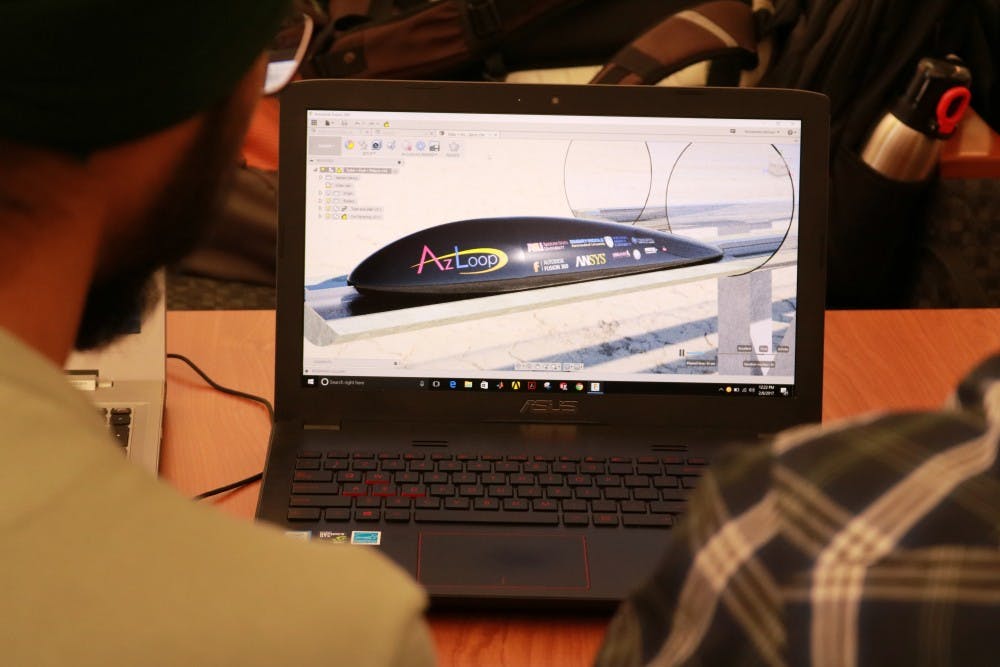AZLoop, Arizona’s SpaceX Hyperloop competition team, is designing a mode of travel that may be faster than airplanes, according team members.
The competition, created by Elon Musk’s SpaceX, challenges teams to create the fastest prototype hyperloop, which is similar to a maglev train inside a depressurized tube, one of AZLoop’s project co-leads said.
Joshua Kosar, the founder and co-lead of AZLoop along with Cherrylynne Nethken, said he has high hopes for its design. He is an undergraduate studying robotic engineering at ASU.
“We’re very confident that we’re going to smoke the rest of the teams,” Kosar said.
He said he has every reason to believe this, too. The design has already made rounds through SpaceX with good reception, Kosar said.
“They were so impressed with our preliminary design briefing, that they not only put us in the next round, but the round after that,” Kosar said.
On Friday, Feb. 10, the team met to finalize their more than 300-page design package, he said.
“After this presentation, we’re going to be OK to build, and we’re going to start constructing the pod,” Kosar said.
His team, which consists of 106 Arizona-based students, designed its entire hyperloop system from the ground up, Kosar said. The students hail from universities around the state, including ASU, NAU and Embry-Riddle Aeronautical University.
He said managing such a vast array of problems and people has been a challenge.
“We’ve broken it down into all of these smaller, more bite-sized problems so that this huge, kind of behemoth of an engineering feat is more attainable,” Kosar said.
Last year, AZLoop was nearly 10 times smaller and still received recognition from SpaceX, though the team’s lack of resources limited how far they could compete that year, Kosar said.
“This semester, we’ve set the ground rules right at the beginning, and we set the expectations high,” he said.
Kosar said they have focused on the aerodynamics of the pod, and will be one of the only teams to construct a test rail.
This should allow the team to fine-tune the pod before testing it with SpaceX, he said.
“By the time we get there, we’re going to know everything is working and ready to rock,” Kosar said.
Still, he said building all of this necessitates many resources and people.
“It takes a village,” Kosar said. “We’re pulling from everywhere we can to try to make this happen.”
Nethken, a masters student studying mechanical engineering, leads AZLoop and considers this interdisciplinary nature one of the team's greatest assets.
"Many people assume we are just an engineering team, but we have pulled in so many students from across the state of Arizona that represent many different fields of study," Nethken said in an email. "Everything from engineering, to business, to astrobiology, and more."
Thomas Koho, co-lead in designing the mechanics for the hyperloop said his team is anxious to start construction. Koho is a graduate student at ASU majoring in aerospace engineering.
“We’re totally at that point where we’re ready to build the thing,” Koho said.
Once built, the pod will levitate using magnets and propel itself by expelling pressurized air, Koho said.
He said that being in charge of the project's mechanics put him in a unique position to help design most subsystems.
“Every step has been a challenge,” Koho said. Although the classic problems of mass and money factor into design decisions, Koho said safety has been the most challenging aspect of the project.
Koho said their pod has to go through a 10-step analysis to validate its safety before final testing.
But this does not mean the process has not been fun, he said.
“It’s been a crazy experience,” Koho said. “It’s been super cool and fun and exciting, as well as incredibly challenging.”
The issues did not stop with design, according to Kelsie Crawford, business lead and an ASU physics and astrophysics undergraduate.
Even though the team has finished designing the pod, Crawford said obtaining the resources to build it is a struggle.
“It’s a lot of reaching out to potential sponsors and going ‘Hey, can we get some kind of funding?’” Crawford said.
She said most private companies are hesitant to give monetary donations, but many donate materials and equipment to the team. This is the final hurdle to making their prototype.
“We have the people, we have the passion, we have the know-how to do it,” Crawford said. “It’s just getting the funding to do it.”
Reach the reporter at chawk3@asu.edu.
Like State Press on Facebook and follow @statepress on Twitter.




